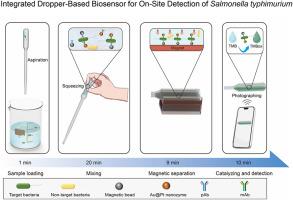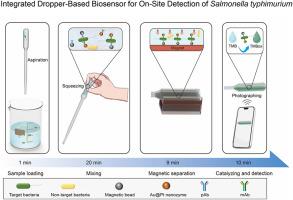Development of a portable dropper-based biosensor for rapid and cost-effective detection of Salmonella typhimurium in food samples
IF 6
2区 化学
Q1 CHEMISTRY, ANALYTICAL
引用次数: 0
Abstract
Background
Foodborne pathogens such as Salmonella typhimurium continue to pose a major threat to public health worldwide. Rapid and reliable on-site screening is crucial to preventing foodborne outbreaks, yet conventional methods such as culture, PCR, and ELISA are time-consuming, require bulky instruments, and lack portability. These limitations are especially problematic in decentralized or resource-limited settings. Current diagnostic tools are inadequate for addressing the need for fast, low-cost, and equipment-free pathogen detection in complex food matrices. Therefore, there is an urgent demand for portable biosensing platforms capable of delivering sensitive and specific results directly at the point-of-need. (94)
Results
We developed a dropper-based biosensor that integrates sample mixing, magnetic separation, and nanozyme-based colorimetric detection within a disposable plastic dropper. The assay involves aspirating the food sample, antibody-functionalized magnetic beads, and Au@Pt nanozymes into the dropper, followed by repeated manual squeezing for incubation. A static magnetic field isolates bead–bacteria–nanozyme complexes from unbound reagents. Upon addition of TMB substrate, a visible color change is triggered by the nanozyme, which can be quantified using a smartphone. Under optimal conditions, the biosensor achieved a linear detection range from 5 × 101 to 5 × 106 CFU/mL and a detection limit of 16 CFU/mL. The entire workflow is completed within 40 min. Specificity studies confirmed no cross-reactivity with non-target bacteria, and the platform demonstrated consistent performance in spiked milk, juice, and chicken meat samples, validating its robustness in diverse food matrices. (143)
Significance
This study presents a portable and affordable tool for rapid pathogen screening, requiring no instruments or professional training. The integration of manual operation, magnetic separation, and smartphone readout offers a practical solution for food safety monitoring in field or low-resource environments. This work advances point-of-care biosensing by offering a simplified yet effective approach to detect Salmonella typhimurium with high sensitivity, specificity, and operational ease. (66)


食品中鼠伤寒沙门菌快速低成本检测便携式滴管式生物传感器的研制
鼠伤寒沙门氏菌等食源性病原体继续对全世界的公共卫生构成重大威胁。快速和可靠的现场筛查对于预防食源性暴发至关重要,然而传统的方法,如培养、PCR和ELISA,耗时长,需要笨重的仪器,并且缺乏便携性。这些限制在分散或资源有限的环境中尤其成问题。目前的诊断工具不足以满足对复杂食物基质中快速、低成本和无设备病原体检测的需求。因此,迫切需要能够在需要的地方直接提供敏感和特定结果的便携式生物传感平台。我们开发了一种基于液滴的生物传感器,它将样品混合、磁分离和纳米酶比色检测集成在一个一次性塑料液滴中。该试验包括将食品样品、抗体功能化磁珠和Au@Pt纳米酶吸入滴管,然后反复手动挤压孵育。静态磁场可从未结合试剂中分离出珠状-细菌-纳米酶复合物。在添加TMB底物后,纳米酶会触发可见的颜色变化,这可以使用智能手机进行量化。在最佳条件下,生物传感器的线性检测范围为5×101 ~ 5×106 CFU/mL,检出限为16 CFU/mL。整个工作流程在40分钟内完成。特异性研究证实,该平台与非目标细菌没有交叉反应性,并且在加了添加剂的牛奶、果汁和鸡肉样品中表现出一致的性能,验证了其在不同食物基质中的稳健性。(143)意义本研究提出了一种便携式且价格合理的快速病原体筛查工具,无需仪器或专业培训。人工操作、磁分离、智能手机读数一体化,为野外或低资源环境下的食品安全监测提供了实用的解决方案。这项工作通过提供一种简单而有效的方法来检测鼠伤寒沙门菌,提高了现场生物传感的灵敏度、特异性和操作便利性。(66)
本文章由计算机程序翻译,如有差异,请以英文原文为准。
求助全文
约1分钟内获得全文
求助全文
来源期刊

Analytica Chimica Acta
化学-分析化学
CiteScore
10.40
自引率
6.50%
发文量
1081
审稿时长
38 days
期刊介绍:
Analytica Chimica Acta has an open access mirror journal Analytica Chimica Acta: X, sharing the same aims and scope, editorial team, submission system and rigorous peer review.
Analytica Chimica Acta provides a forum for the rapid publication of original research, and critical, comprehensive reviews dealing with all aspects of fundamental and applied modern analytical chemistry. The journal welcomes the submission of research papers which report studies concerning the development of new and significant analytical methodologies. In determining the suitability of submitted articles for publication, particular scrutiny will be placed on the degree of novelty and impact of the research and the extent to which it adds to the existing body of knowledge in analytical chemistry.
 求助内容:
求助内容: 应助结果提醒方式:
应助结果提醒方式:


